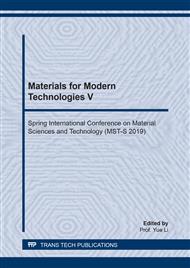[1]
G. Zhang, Y.-x. Zhou, Y. Kong, Z.-m. Li, S.-R. Long, J. Yang, Semiaromatic polyamides containing ether and different numbers of methylene (2–10) units: synthesis and properties, Rsc Advances, 4 (2014) 63006-63015.
DOI: 10.1039/c4ra10074c
Google Scholar
[2]
M. Peng, G. Xiao, X. Tang, Y. Zhou, Hydrogen-bonding assembly of rigid-rod poly (p-sulfophenylene terephthalamide) and flexible-chain poly (vinyl alcohol) for transparent, strong, and tough molecular composites, Macromolecules, 47 (2014) 8411-8419.
DOI: 10.1021/ma501590x
Google Scholar
[3]
S.-J. Park, W. Choi, S.-E. Nam, S. Hong, J.S. Lee, J.-H. Lee, Fabrication of polyamide thin film composite reverse osmosis membranes via support-free interfacial polymerization, Journal of Membrane Science, 526 (2017) 52-59.
DOI: 10.1016/j.memsci.2016.12.027
Google Scholar
[4]
S. Dewilde, J. Winters, W. Dehaen, K. Binnemans, Polymerization of PPTA in Ionic Liquid/Cosolvent Mixtures, Macromolecules, 50 (2017) 3089-3100.
DOI: 10.1021/acs.macromol.7b00579
Google Scholar
[5]
S. Dewilde, T.V. Hoogerstraete, W. Dehaen, K. Binnemans, Synthesis of poly-p-phenylene terephthalamide (PPTA) in ionic liquids, Acs Sustainable Chemistry & Engineering, 6 (2017) 1362-1369.
DOI: 10.1021/acssuschemeng.7b03727
Google Scholar
[6]
Q. Wang, Z. Chen, S. Deng, S. Song, C. Xiong, L. Dong, Fluxible poly (p-phenyleneterephthalamide)-based polymer with tunable condensed state structure and controllable rheology behaviors, Chemical Engineering Journal, 328 (2017) 343-352.
DOI: 10.1016/j.cej.2017.06.185
Google Scholar
[7]
C. de Ruijter, W.F. Jager, J. Groenewold, S.J. Picken, Synthesis and characterization of rod− coil poly (amide-block-aramid) alternating block copolymers, Macromolecules, 39 (2006) 3824-3829.
DOI: 10.1021/ma052228i
Google Scholar
[8]
T. Wright, C. Carr, C.A. Grant, V. Lilladhar, S. Russell, Strength of hydroentangled fabrics manufactured from photo-irradiated poly para-phenylene terephthalamide (PPTA) fibres, Polymer degradation and stability, 121 (2015) 193-199.
DOI: 10.1016/j.polymdegradstab.2015.08.017
Google Scholar
[9]
N. Li, X.-K. Zhang, J.-R. Yu, Y. Wang, J. Zhu, Z.-M. Hu, Synthesis and Characterization of Easily Colored Meta-aramid Copolymer Containing Ether Bonds, Chinese Journal of Polymer Science, 37 (2019) 227-234.
DOI: 10.1007/s10118-019-2200-9
Google Scholar
[10]
S. Qiang, N. Lei, Y. Zhang, X. Feng, Q. Chang, J. Meng, Poly(p-phenylene terephthamide) embedded in a polysulfone as the substrate for improving compaction resistance and adhesion of a thin film composite polyamide membrane, Journal of Materials Chemistry A, 5 (2017).
DOI: 10.1039/c7ta02552a
Google Scholar
[11]
C. Fernández, M. Bermúdez, A. Alla, M. Mancera, M. García‐Martín, E. Benito, I. Roffe, J. Galbis, S. Muñoz‐Guerra, Crystallization studies on linear aliphatic polyamides derived from naturally occurring carbohydrates, Journal of applied polymer science, 116 (2010) 2515-2525.
DOI: 10.1002/app.31759
Google Scholar
[12]
M. Takayanagi, T. Ogata, M. Morikawa, T. Kai, Polymer composites of rigid and flexible molecules: system of wholly aromatic and aliphatic polyamides, Journal of Macromolecular Science, Part B: Physics, 17 (1980) 591-615.
DOI: 10.1080/00222348008212828
Google Scholar
[13]
W.Z. Wang, W.Z. Wang, Environment-friendly synthesis of long chain semiaromatic polyamides, Journal of Applied Polymer Science, 3 (2009) 2036-2042.
DOI: 10.1002/app.30774
Google Scholar
[14]
J.P. Singhal, A.R. Ray, Synthesis of blood compatible polyamide block copolymers, Biomaterials, 23 (2002) 1139-1145.
DOI: 10.1016/s0142-9612(01)00228-9
Google Scholar
[15]
S. Khademinejad, S. Mehdipour-Ataei, Aromatic Polyamide/Sepiolite Nanocomposite Materials: Synthesis, Structure, and Properties, Polymer-Plastics Technology and Engineering, 56 (2017) 1916-1922.
DOI: 10.1080/03602559.2017.1295315
Google Scholar
[16]
LanQu, Sheng-RuLong, Mei-LinZhang, GangZhang, Xiao-JunWang, JieYang, Synthesis and Characterization of Poly(ethylene terephthalamide/hexamethylene terephthalamide), Journal of Macromolecular Science: Part A - Chemistry, 49 (2012) 67-72.
DOI: 10.1080/10601325.2012.630950
Google Scholar
[17]
Z. Yang, W. Ying, G. Pan, H. Shi, Y. Hao, X. Jian, G. Min, W. Zhe, Y. Liu, Surface modification of polyamide reverse osmosis membrane with sulfonated polyvinyl alcohol for antifouling, Applied Surface Science, 419 (2017) 177-187.
DOI: 10.1016/j.apsusc.2017.05.047
Google Scholar
[18]
W. Wang, Q. Xiang, G. Yan, Z. Fei, Z. Jie, C. Yan, Y. Zhu, X. Wan, Synthesis and Properties of Poly(p-phenylene terephthalamide) Bearing Both Polar and Unsaturated Substituents Introduced via Claisen Rearrangement Reaction, Journal of Polymer Science Part A Polymer Chemistry, 54 (2016) 2050-2059.
DOI: 10.1002/pola.28072
Google Scholar


